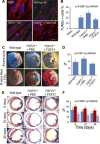Fibroblast growth factors in cardiovascular disease: The emerging role of FGF21
- PMID: 26232236
- PMCID: PMC4747916
- DOI: 10.1152/ajpheart.00527.2015
Fibroblast growth factors in cardiovascular disease: The emerging role of FGF21
Abstract
Early detection of risk factors for enhanced primary prevention and novel therapies for treating the chronic consequences of cardiovascular disease are of the utmost importance for reducing morbidity. Recently, fibroblast growth factors (FGFs) have been intensively studied as potential new molecules in the prevention and treatment of cardiovascular disease mainly attributable to metabolic effects and angiogenic actions. Members of the endocrine FGF family have been shown to increase metabolic rate, decrease adiposity, and restore glucose homeostasis, suggesting a multiple metabolic role. Serum levels of FGFs have been associated with established cardiovascular risk factors as well as with the severity and extent of coronary artery disease and could be useful for prediction of cardiovascular death. Furthermore, preclinical investigations and clinical trials have tested FGF administration for therapeutic angiogenesis in ischemic vascular disease, demonstrating a potential role in improving angina and limb function. FGF21 has lately emerged as a potent metabolic regulator with multiple effects that ultimately improve the lipoprotein profile. Early studies show that FGF21 is associated with the presence of atherosclerosis and may play a protective role against plaque formation by improving endothelial function. The present review highlights recent investigations suggesting that FGFs, in particular FGF21, may be useful as markers of cardiovascular risk and may also serve as protective/therapeutic agents in cardiovascular disease.
Keywords: angiogenesis; atherosclerosis; biomarker; coronary artery disease; fibroblast growth factor.
Copyright © 2015 the American Physiological Society.
Figures




Similar articles
-
Targeting FGF21 in cardiovascular and metabolic diseases: from mechanism to medicine.Int J Biol Sci. 2023 Jan 1;19(1):66-88. doi: 10.7150/ijbs.73936. eCollection 2023. Int J Biol Sci. 2023. PMID: 36594101 Free PMC article. Review.
-
Effect of Fibroblast Growth Factor 21 on the Development of Atheromatous Plaque and Lipid Metabolic Profiles in an Atherosclerosis-Prone Mouse Model.Int J Mol Sci. 2020 Sep 17;21(18):6836. doi: 10.3390/ijms21186836. Int J Mol Sci. 2020. PMID: 32957703 Free PMC article.
-
Fibroblast Growth Factors in Cardiovascular Disease.J Atheroscler Thromb. 2024 Nov 1;31(11):1496-1511. doi: 10.5551/jat.RV22025. Epub 2024 Aug 22. J Atheroscler Thromb. 2024. PMID: 39168622 Free PMC article. Review.
-
Pharmacological treatment with FGF21 strongly improves plasma cholesterol metabolism to reduce atherosclerosis.Cardiovasc Res. 2022 Jan 29;118(2):489-502. doi: 10.1093/cvr/cvab076. Cardiovasc Res. 2022. PMID: 33693480 Free PMC article.
-
The role of fibroblast growth factor 21 in atherosclerosis.Atherosclerosis. 2017 Feb;257:259-265. doi: 10.1016/j.atherosclerosis.2016.11.033. Epub 2016 Dec 1. Atherosclerosis. 2017. PMID: 28012645 Review.
Cited by
-
Roles of FGF Signals in Heart Development, Health, and Disease.Front Cell Dev Biol. 2016 Oct 18;4:110. doi: 10.3389/fcell.2016.00110. eCollection 2016. Front Cell Dev Biol. 2016. PMID: 27803896 Free PMC article. Review.
-
Circulating level of fibroblast growth factor 21 is independently associated with the risks of unstable angina pectoris.Biosci Rep. 2018 Sep 25;38(5):BSR20181099. doi: 10.1042/BSR20181099. Print 2018 Oct 31. Biosci Rep. 2018. PMID: 30185439 Free PMC article.
-
Serum FGF21 Levels Predict the MACE in Patients With Myocardial Infarction After Coronary Artery Bypass Graft Surgery.Front Cardiovasc Med. 2022 Apr 6;9:850517. doi: 10.3389/fcvm.2022.850517. eCollection 2022. Front Cardiovasc Med. 2022. PMID: 35463746 Free PMC article.
-
Adipose Tissue Distribution, Inflammation and Its Metabolic Consequences, Including Diabetes and Cardiovascular Disease.Front Cardiovasc Med. 2020 Feb 25;7:22. doi: 10.3389/fcvm.2020.00022. eCollection 2020. Front Cardiovasc Med. 2020. PMID: 32158768 Free PMC article. Review.
-
Neurohumoral, cardiac and inflammatory markers in the evaluation of heart failure severity and progression.J Geriatr Cardiol. 2021 Jan 28;18(1):47-66. doi: 10.11909/j.issn.1671-5411.2021.01.007. J Geriatr Cardiol. 2021. PMID: 33613659 Free PMC article.
References
-
- An SY, Lee MS, Yi SA, Ha ES, Han SJ, Kim HJ, Kim DJ, Lee KW. Serum fibroblast growth factor 21 was elevated in subjects with type 2 diabetes mellitus and was associated with the presence of carotid artery plaques. Diabetes Res Clin Pract 96: 196–203, 2012. - PubMed
-
- Badman MK, Pissios P, Kennedy AR, Koukos G, Flier JS, Maratos-Flier E. Hepatic fibroblast growth factor 21 is regulated by PPARalpha and is a key mediator of hepatic lipid metabolism in ketotic states. Cell Metab 5: 426–437, 2007. - PubMed
-
- Barutcuoglu B, Basol G, Cakir Y, Cetinkalp S, Parildar Z, Kabaroglu C, Ozmen D, Mutaf I, Bayindir O. Fibroblast growth factor-19 levels in type 2 diabetic patients with metabolic syndrome. Ann Clin Lab Sci 41: 390–396, 2011. - PubMed
-
- Battler A, Scheinowitz M, Bor A, Hasdai D, Vered Z, Di Segni E, Varda-Bloom N, Nass D, Engelberg S, Eldar M, Belkin M, Savion N. Intracoronary injection of basic fibroblast growth factor enhances angiogenesis in infarcted swine myocardium. J Am Coll Cardiol 22: 2001–2006, 1993. - PubMed
Publication types
MeSH terms
Substances
Grants and funding
LinkOut - more resources
Full Text Sources
Other Literature Sources
Medical

